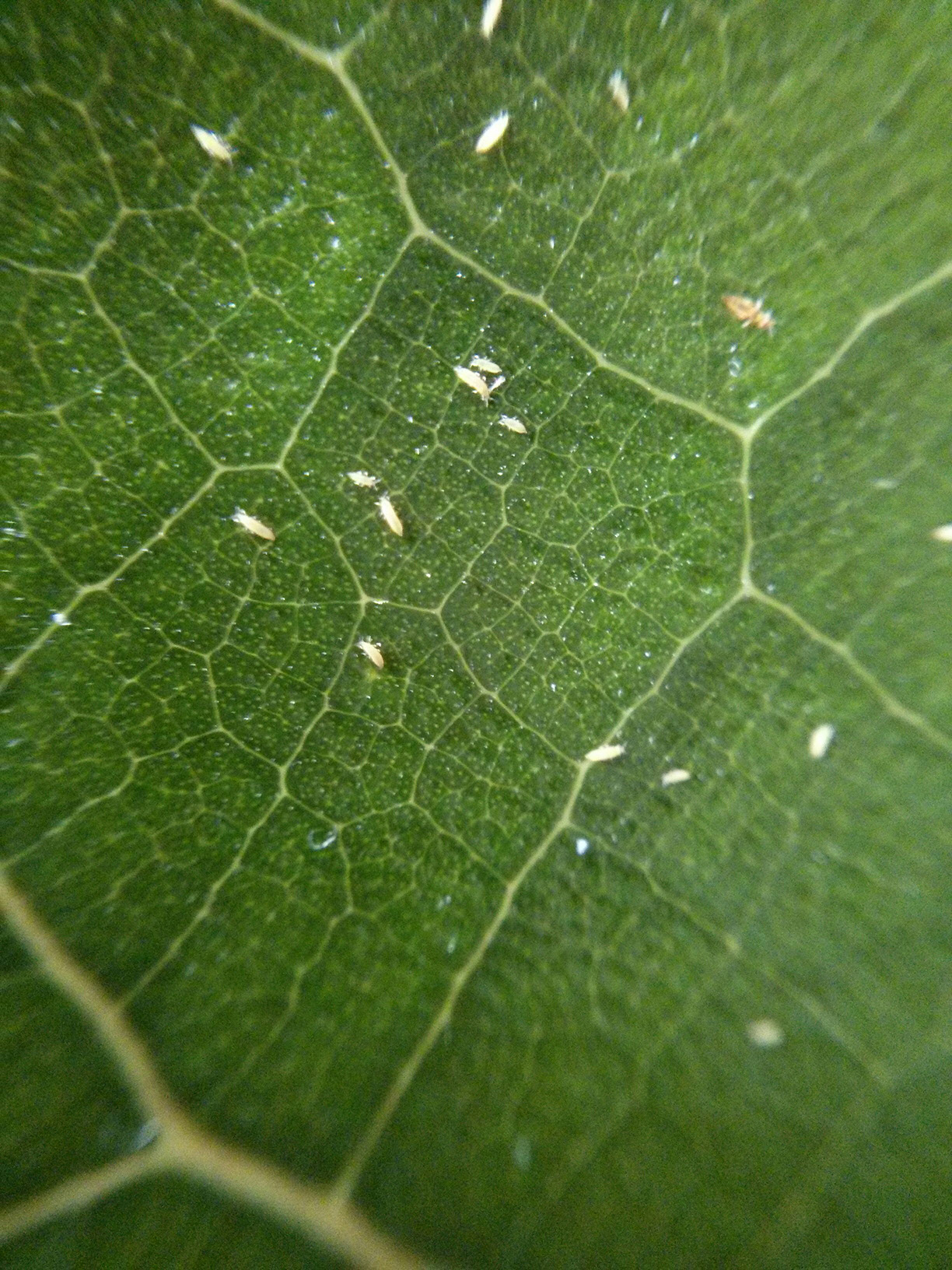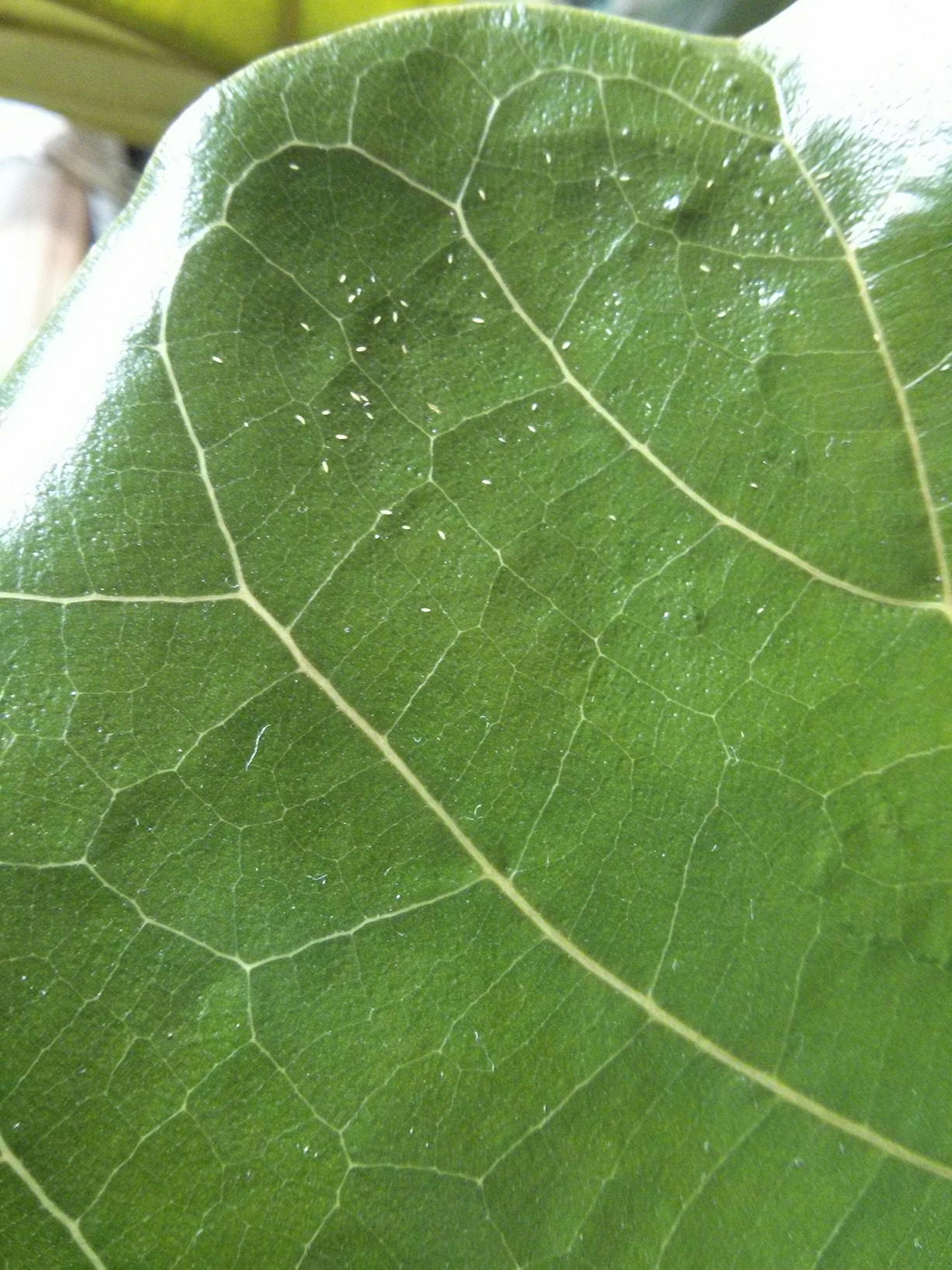
"Thrips on Plant: A Gallery ..." from www.houseplantjournal.com and used with no modifications.
Thrips may be small, but they can cause significant damage to your indoor garden. These tiny insects are experts at finding their way into your garden and making themselves at home, much to the detriment of your plants. Knowing how to identify and manage these pests is essential for keeping your plants healthy and thriving.
Thrips are tiny, skinny bugs that usually measure less than 1/16 of an inch in length. They're usually yellow, brown, or black in colour and have wings with fringe. They might catch your attention as they fly around your plants, or you might see them on the bottom of leaves. Even though they're small, they can cause a lot of damage by sucking the sap out of plants.
Thrips feed on plants by puncturing the plant's tissue and sucking out the sap. This leaves behind silver or bronze streaks on the leaves, which can cause discolouration and distorted growth over time. You might also see small black specks, which is the thrips' waste. Other than these visual signs, you might notice that your plant isn't growing as well or is less healthy than usual.
Spotting thrips early on is the key to stopping a major infestation. Make sure to check your plants often, especially the undersides of leaves and new growth, as these are the places thrips like to hang out. A magnifying glass can help you get a better look at these tiny bugs. Another good trick is to gently shake the plant over a white piece of paper. If there are thrips, they'll fall onto the paper and be easier to spot.
One of the best ways to catch thrips and get alerted to their presence is by setting up sticky traps near your plants. These traps are a cheap and easy way to use, and they can help give you an early warning for any pest activity. "Eliminate Thrips"

"Thrips on Houseplants: A Gallery ..." from www.houseplantjournal.com and used with no modifications.
The first step in preventing thrips infestations is to make your plant environment as unattractive as possible to these pests. This is known as cultural control. One of the easiest and most effective ways to do this is to keep your grow room clean. Regularly remove any plant debris, fallen leaves, or dead plant matter, as these can all be hiding places for thrips and other pests.
One of the most important things you can do to prevent thrips from infesting your indoor plants is to make sure your plants aren’t too close together. Thrips love warm, humid environments, and they thrive in them. So, it’s important to space your plants out enough so that there’s good air circulation. You might even want to think about using a fan to help get the air moving.
Releasing good bugs, like ladybugs and lacewings, into your indoor garden is a safe and natural way to get rid of thrips. These beneficial insects love to snack on thrips, and they can help keep the pest population under control.
Not only are these beneficial insects harmless to your plants, but they also don't cause any damage. You can buy them from garden centers or online retailers. Release them into your grow room, and let them handle the thrips for you.
Aside from ladybugs and lacewings, there are other natural predators that can help control the thrips population. Parasitic wasps, like the Thripobius semiluteus, specifically prey on thrips larvae, offering a more focused method of pest control.
It's all about timing when it comes to introducing natural predators. Release them when thrips populations are low. This gives the predators time to get settled and effectively manage the thrips before they can become an infestation.
It's critical to keep a close watch on your plants to catch thrips early on and prevent them from doing a lot of harm. Make a point of checking your plants at least once a week. Keep an eye out for signs of thrips damage, such as silver streaks on leaves or distorted growth.
Primarily, watch out for new growth because thrips are especially drawn to soft, young leaves. By being alert, you can spot any problems early and deal with them before they become major issues.
Regular checks are important, but you might also want to think about using a handheld vacuum to get rid of thrips on your plants. This is a non-toxic way to control the problem and can be especially useful if you only have a small number of thrips to deal with.

"Preventing and Eliminating Thrips on ..." from zenrockford.com and used with no modifications.
One of the best ways to stop thrips from infesting your plants is to create the perfect growing conditions. Plants that are healthy and growing well are much better at dealing with pests. Make sure your plants get enough light, as this will help them grow strong and can also help to keep thrips away.
Make sure you water your plants regularly, but be careful not to overdo it, as this can create the perfect environment for thrips. Use a soil mix that drains well to avoid waterlogging and root rot, which can weaken your plants and make them more susceptible to pests.
It’s also important to fertilize properly. Give your plants the nutrients they need to grow strong and healthy. A balanced fertilizer, applied according to the manufacturer’s instructions, can help support strong plant growth and natural defenses.
By putting these cultural controls into action and introducing natural predators, you can effectively manage thrips and keep your indoor plants alive and well.
How do I know if my houseplants have thrips? The first signs that your houseplants might have thrips include silver streaks or patches on the leaves, new growth that appears distorted, and small black specks that are actually thrip excrement.
If your indoor plants have thrips, you'll likely notice silver or bronze streaks on the leaves. The leaves might also start to look distorted or take on a papery texture. This is because thrips feed by puncturing the plant cells and sucking out the contents, which results in these telltale signs. You might also see small black specks on the leaves, which are actually thrips' droppings. Being aware of these early signs of thrips can help you take action before your plants are overrun.
You should ideally inspect your plants for thrips on a weekly basis. By doing regular checks, you can detect any signs of infestation early and act quickly. When looking for thrips, pay particular attention to the undersides of leaves and new growth, as these are the areas where thrips are most likely to gather. A magnifying glass can be a useful tool for spotting these minuscule pests. Regular checks are crucial for keeping thrips under control and maintaining the health of your plants.
Indeed, thrips do have preferences when it comes to plants. They are especially attracted to plants with delicate, soft leaves, making houseplants like African violets, begonias, and ferns more susceptible. Flowering plants, such as roses and orchids, are also a favorite of thrips, as they can feed on both the leaves and the flowers. If you have these types of plants, it's crucial to keep a close eye on them for thrips and take steps to prevent an infestation.
There are a number of natural remedies that can help control thrips. One method is to introduce beneficial insects such as ladybugs and lacewings, which are known to prey on thrips, helping to keep their numbers under control. Another method is to use neem oil, a natural pesticide that is safe for most plants and works by interfering with the life cycle of the pests. To use, simply spray the affected plants with a solution of neem oil, following the instructions on the bottle for best results.
Although it can be difficult to completely get rid of thrips, especially in large or outdoor settings, it is possible to manage and significantly reduce their populations. By combining regular monitoring, cultural controls, and natural treatments, you can keep thrips under control and minimise their impact on your plants. It's important to remain vigilant and proactive, as thrips can quickly reproduce and spread if left unchecked. By maintaining healthy plants and a clean growing environment, you can reduce the likelihood of thrips becoming a persistent problem.
If you need to speak to someone about the infestation, give us a call and we will do our best to guide and recommend the products and actions we would do ourselves.